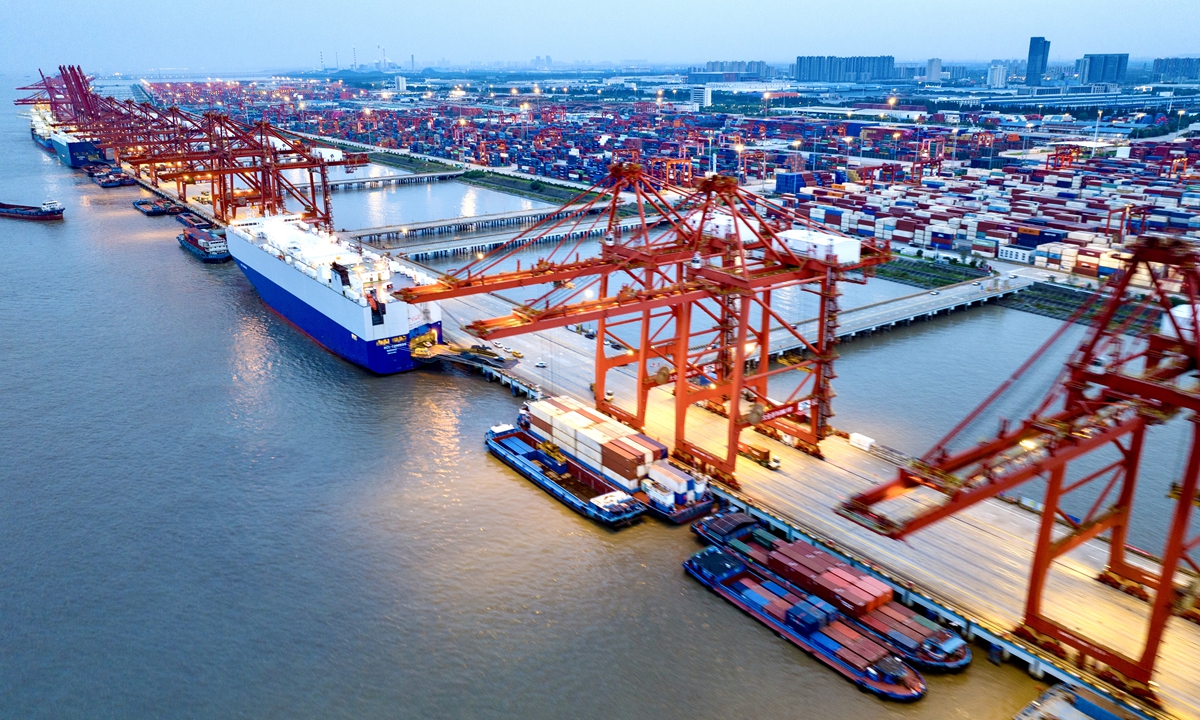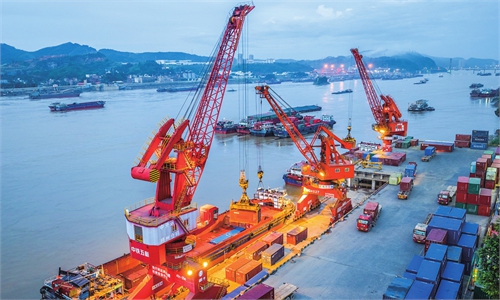
Ships park at a container terminal at the fourth phase project of the Taicang Port in East China's Jiangsu Province, on July 9, 2024. Photo: VCG
China's seaborne container shipments to the US jumped 15 percent year-on-year by volume in June, showing resilient supply and demand between the world's two largest economies despite intensified decoupling attempts by the US, industry experts said.
Multiple factors contributed to the growth, including the early preparation and delivery of products for Christmas as well as a seasonal shopping spree that falls in late November.
According to US-based research company Descartes Datamyne, the numbers of 20-foot containers moved from Asia to the US in June increased by 16 percent year-on-year, Nikkei reported on Monday. It was the 10th consecutive month of year-on-year growth.
The Chinese mainland, which accounted for nearly 60 percent of the total volume, rose 15 percent, the Nikkei reported.
All of the top 10 products exceeded the same period last year. The largest increase was in automotive-related products, which grew by 25 percent, followed by textile products, which rose by 24 percent, according to the report.
The figures are in line with data released by China's General Administration of Customs on July 12. In June, China-US trade amounted to 420.94 billion yuan ($57.8 billion), a year-on-year increase of 2.9 percent. China's exports to the US rose by 4.7 percent, maintaining a positive trend.
Chinese experts said that the trend shows that China-US trade relations remain resilient and strong, despite the US government's attempts to decouple from China.
"The resilient state of supply and demand between the two major economies played an important factor in driving the growth," Gao Lingyun, an expert at the Chinese Academy of Social Sciences, told the Global Times on Tuesday.
Another reason for the rising cargo volume might be that businesses are speculating about possible heavier tariffs, depending on the US presidential election result, so they're ramping up goods production and delivery, Gao said.
But that's unlikely, since it could backfire on American consumers as well, Gao added.
"There is a trend this year - that is, July and August were normally the busiest in terms of the start of the peak season in the US in previous years, but this year it was brought forward from May," Zhong Zhechao, founder of One Shipping, an international logistics service consulting firm, told the Global Times on Tuesday.
There are multiple reasons for this change, including a high demand for Chinese goods.
Businesses are working in full swing to deliver goods for the upcoming Christmas and Black Friday shopping sprees, which are seeing strong demand as the US inflation level is reportedly declining, Zhong said.
Consumers vote with their wallets. The scale of cargo trade shows that China-made goods are still gaining popularity among American consumers as these products offer more value for money, the industry insider noted.
Other driver for the strong trade growth is the speculation about a possible port workers' strike along the US East Coast, after their labor contracts expire in late September, Zhong said.
Zhong said that the strong cargo trend may peak in July and decline after August.
A large US business delegation is visiting China this week, and its members said that the US business community is confident in continuing to deepen cooperation with China and committed to building a strong, balanced bilateral relationship, the Xinhua News Agency reported.


